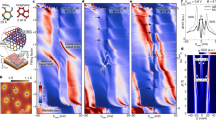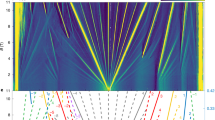Abstract
Interactions between electrons and the topology of their energy bands can create unusual quantum phases of matter. Most topological electronic phases appear in systems with weak electron–electron interactions. The instances in which topological phases emerge only as a result of strong interactions are rare and mostly limited to those realized in intense magnetic fields1. The discovery of flat electronic bands with topological character in magic-angle twisted bilayer graphene (MATBG) has created a unique opportunity to search for strongly correlated topological phases2,3,4,5,6,7,8,9. Here we introduce a local spectroscopic technique using a scanning tunnelling microscope to detect a sequence of topological insulators in MATBG with Chern numbers C = ±1, ±2 and ±3, which form near filling factors of ±3, ±2 and ±1 electrons per moiré unit cell, respectively, and are stabilized by modest magnetic fields. One of the phases detected here (C = +1) was previously observed when the sublattice symmetry of MATBG was intentionally broken by a hexagonal boron nitride substrate, with interactions having a secondary role9. We demonstrate that strong electron–electron interactions alone can produce not only the previously observed phase, but also other unexpected Chern insulating phases in MATBG. The full sequence of phases that we observe can be understood by postulating that strong correlations favour breaking time-reversal symmetry to form Chern insulators that are stabilized by weak magnetic fields. Our findings illustrate that many-body correlations can create topological phases in moiré systems beyond those anticipated from weakly interacting models.
This is a preview of subscription content, access via your institution
Access options
Access Nature and 54 other Nature Portfolio journals
Get Nature+, our best-value online-access subscription
$29.99 / 30 days
cancel any time
Subscribe to this journal
Receive 51 print issues and online access
$199.00 per year
only $3.90 per issue
Buy this article
- Purchase on Springer Link
- Instant access to full article PDF
Prices may be subject to local taxes which are calculated during checkout




Similar content being viewed by others
Data availability
The data that support the findings of this study are available from the corresponding author upon reasonable request.
References
Rachel, S. Interacting topological insulators: a review. Rep. Prog. Phys. 81, 116501 (2018).
Bistritzer, R. & MacDonald, A. H. Moire bands in twisted double-layer graphene. Proc. Natl Acad. Sci. USA 108, 12233–12237 (2011).
Suárez Morell, E., Correa, J. D., Vargas, P., Pacheco, M. & Barticevic, Z. Flat bands in slightly twisted bilayer graphene: tight-binding calculations. Phys. Rev. B 82, 121407 (2010).
Cao, Y. et al. Correlated insulator behaviour at half-filling in magic-angle graphene superlattices. Nature 556, 80–84 (2018).
Cao, Y. et al. Unconventional superconductivity in magic-angle graphene superlattices. Nature 556, 43–50 (2018).
Yankowitz, M. et al. Tuning superconductivity in twisted bilayer graphene. Science 363, 1059–1064 (2019).
Lu, X. et al. Superconductors, orbital magnets and correlated states in magic-angle bilayer graphene. Nature 574, 653–657 (2019).
Sharpe, A. L. et al. Emergent ferromagnetism near three-quarters filling in twisted bilayer graphene. Science 365, 605–608 (2019).
Serlin, M. et al. Intrinsic quantized anomalous Hall effect in a moiré heterostructure. Science 367, 900–903 (2020).
Chen, G. et al. Tunable correlated Chern insulator and ferromagnetism in a moiré superlattice. Nature 579, 56–61 (2020); correction 581, E3 (2020).
Polshyn, H. et al. Electrical switching of magnetic order in an orbital Chern insulator. Nature 588, 66–70 (2020).
Chen, S. et al. Electrically tunable correlated and topological states in twisted monolayer-bilayer graphene. Nat. Phys. https://doi.org/10.1038/s41567-020-01062-6 (2020).
Liu, J. & Dai, X. Theories for the correlated insulating states and quantum anomalous Hall phenomena in twisted bilayer graphene. Preprint at https://arxiv.org/abs/1911.03760 (2019).
Stepanov, P. et al. Untying the insulating and superconducting orders in magic-angle graphene. Nature 583, 375–378 (2020).
Haldane, F. D. M. Model for a quantum Hall effect without Landau levels: condensed-matter realization of the “parity anomaly”. Phys. Rev. Lett. 61, 2015–2018 (1988).
Wong, D. et al. A modular ultra-high vacuum millikelvin scanning tunneling microscope. Rev. Sci. Instrum. 91, 023703 (2020).
Li, G. et al. Observation of Van Hove singularities in twisted graphene layers. Nat. Phys. 6, 109–113 (2010).
Brihuega, I. et al. Unraveling the intrinsic and robust nature of Van Hove singularities in twisted bilayer graphene by scanning tunneling microscopy and theoretical analysis. Phys. Rev. Lett. 109, 196802 (2012).
Wong, D. et al. Local spectroscopy of moiré-induced electronic structure in gate-tunable twisted bilayer graphene. Phys. Rev. B 92, 155409 (2015).
Xie, Y. et al. Spectroscopic signatures of many-body correlations in magic-angle twisted bilayer graphene. Nature 572, 101–105 (2019).
Wong, D. et al. Cascade of electronic transitions in magic-angle twisted bilayer graphene. Nature 582, 198–202 (2020).
Zondiner, U. et al. Cascade of phase transitions and Dirac revivals in magic-angle graphene. Nature 582, 203–208 (2020).
Choi, Y. et al. Electronic correlations in twisted bilayer graphene near the magic angle. Nat. Phys. 15, 1174–1180 (2019); correction 15, 1205 (2019).
Kerelsky, A. et al. Maximized electron interactions at the magic angle in twisted bilayer graphene. Nature 572, 95–100 (2019).
Jiang, Y. et al. Charge order and broken rotational symmetry in magic-angle twisted bilayer graphene. Nature 573, 91–95 (2019).
Lian, B., Xie, F. & Bernevig, B. A. Landau level of fragile topology. Phys. Rev. B 102, 041402 (2020).
Bi, Z., Yuan, N. F. Q. & Fu, L. Designing flat bands by strain. Phys. Rev. B 100, 035448 (2019).
Moon, P., Son, Y. W. & Koshino, M. Optical absorption of twisted bilayer graphene with interlayer potential asymmetry. Phys. Rev. B 90, 155427 (2014).
Bultinck, N., Chatterjee, S. & Zaletel, M. P. Mechanism for anomalous Hall ferromagnetism in twisted bilayer graphene. Phys. Rev. Lett. 124, 166601 (2020).
Nomura, K. & MacDonald, A. H. Quantum Hall ferromagnetism in graphene. Phys. Rev. Lett. 96, 256602 (2006).
Young, A. F. et al. Spin and valley quantum Hall ferromagnetism in graphene. Nat. Phys. 8, 550–556 (2012).
Song, Y. J. et al. High-resolution tunnelling spectroscopy of a graphene quartet. Nature 467, 185–189 (2010).
Feldman, B. E. et al. Observation of a nematic quantum Hall liquid on the surface of bismuth. Science 354, 316–321 (2016).
Randeria, M. T. et al. Interacting multi-channel topological boundary modes in a quantum Hall valley system. Nature 566, 363–367 (2019).
Středa, P. Theory of quantised Hall conductivity in two dimensions. J. Phys. C 15, L717 (1982).
Spanton, E. M. et al. Observation of fractional Chern insulators in a van der Waals heterostructure. Science 360, 62–66 (2018).
Tomarken, S. L. et al. Electronic compressibility of magic-angle graphene superlattices. Phys. Rev. Lett. 123, 046601 (2019).
Abouelkomsan, A., Liu, Z. & Bergholtz, E. J. Particle-hole duality, emergent Fermi liquids, and fractional Chern insulators in moiré flatbands. Phys. Rev. Lett. 124, 106803 (2020).
Ledwith, P. J., Tarnopolsky, G., Khalaf, E. & Vishwanath, A. Fractional Chern insulator states in twisted bilayer graphene: an analytical approach. Phys. Rev. Res. 2, 023237 (2020).
Repellin, C. & Senthil, T. Chern bands of twisted bilayer graphene: fractional Chern insulators and spin phase transition. Phys. Rev. Res. 2, 023238 (2019).
Deng, Y. et al. Quantum anomalous Hall effect in intrinsic magnetic topological insulator MnBi2Te4. Science 367, 895–900 (2020).
Liu, C. et al. Helical Chern insulator phase with broken time-reversal symmetry in MnBi2Te4. Preprint at https://arxiv.org/abs/2001.08401 (2020).
Zhang, Y. H., Mao, D., Cao, Y., Jarillo-Herrero, P. & Senthil, T. Nearly flat Chern bands in moiré superlattices. Phys. Rev. B 99, 075127 (2019).
Acknowledgements
We thank S. Wu, B. Jaeck, X. Liu, K. Hejazi, N. Yuan and L. Fu for discussions. This work was primarily supported by the Gordon and Betty Moore Foundation’s EPiQS initiative grants GBMF4530, GBMF9469 and DOE-BES grant DE-FG02-07ER46419 to A.Y. Other support for the experimental work was provided by NSF-MRSEC through the Princeton Center for Complex Materials NSF-DMR-1420541, NSF-DMR-1904442, ExxonMobil through the Andlinger Center for Energy and the Environment at Princeton, and the Princeton Catalysis Initiative. K.W. and T.T. acknowledge support from the Elemental Strategy Initiative conducted by MEXT, Japan, grant JPMXP0112101001, JSPS KAKENHI grant JP20H00354, and CREST (JPMJCR15F3), JST. B.L. acknowledges support from the Princeton Center for Theoretical Science at Princeton University. B.A.B. acknowledges support from the Department of Energy DE-SC0016239, Simons Investigator Award, the Packard Foundation, the Schmidt Fund for Innovative Research, NSF EAGER grant DMR-1643312, NSF-MRSEC DMR1420541, BSF Israel US foundation number 2018226, ONR number N00014-20-1-2303, and the Princeton Global Network Funds.
Author information
Authors and Affiliations
Contributions
K.P.N., M.O., D.W. and A.Y. designed the experiment. K.P.N., D.W. and M.O. fabricated samples, carried out STM/STS measurements and performed the data analysis. B.L. and B.A.B. performed the theoretical calculations. K.W. and T.T. synthesized the hBN crystals. All authors discussed the results and contributed to the writing of the manuscript.
Corresponding author
Ethics declarations
Competing interests
The authors declare no competing interests.
Additional information
Peer review information Nature thanks Vincent Renard, Yayu Wang and the other, anonymous, reviewer(s) for their contribution to the peer review of this work.
Publisher’s note Springer Nature remains neutral with regard to jurisdictional claims in published maps and institutional affiliations.
Supplementary information
Supplementary Information
This file contains Supplementary Text, Supplementary References and Supplementary Figures 1–14.
Rights and permissions
About this article
Cite this article
Nuckolls, K.P., Oh, M., Wong, D. et al. Strongly correlated Chern insulators in magic-angle twisted bilayer graphene. Nature 588, 610–615 (2020). https://doi.org/10.1038/s41586-020-3028-8
Received:
Accepted:
Published:
Issue Date:
DOI: https://doi.org/10.1038/s41586-020-3028-8
This article is cited by
-
Anomalous and Chern topological waves in hyperbolic networks
Nature Communications (2024)
-
Disorder scattering in classical flat channel transport of particles between twisted magnetic square patterns
Communications Physics (2024)
-
Layer-polarized ferromagnetism in rhombohedral multilayer graphene
Nature Communications (2024)
-
Non-Abelian topological superconductivity in maximally twisted double-layer spin-triplet valley-singlet superconductors
Communications Physics (2023)
-
Dirac spectroscopy of strongly correlated phases in twisted trilayer graphene
Nature Materials (2023)
Comments
By submitting a comment you agree to abide by our Terms and Community Guidelines. If you find something abusive or that does not comply with our terms or guidelines please flag it as inappropriate.



